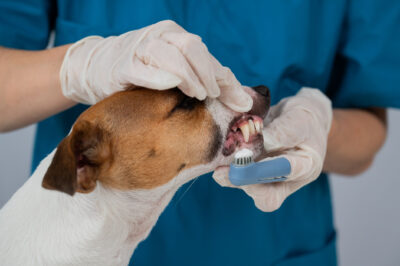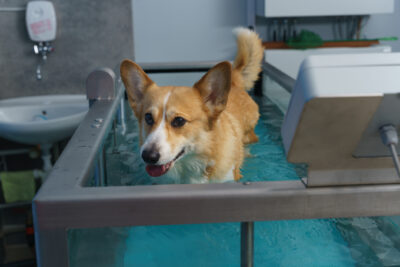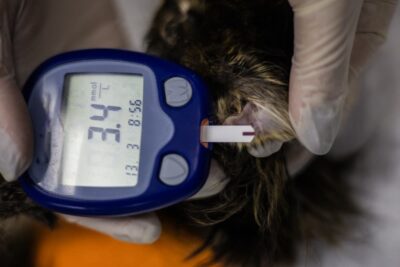Chlorhexidine for Dogs: Benefits and Uses

All featured products are chosen at the discretion of the GreatPetCare editorial team and do not reflect a direct endorsement by the author or reviewer.
If your dog has ever had a bacterial infection on their skin, then there is a possibility they were prescribed a product that contained an ingredient called chlorhexidine. But what is chlorhexidine and how does it work?
Read on to learn more about chlorhexidine for dogs and how this antiseptic substance can help eliminate bacterial infections in pets.
What Is Chlorhexidine for Dogs?

Chlorhexidine is a chemical substance that has both antiseptic and disinfectant properties. Chlorhexidine gluconate is the most common form used by veterinary professionals, and it has many applications. It has been in use since the 1950s and is available via prescription and over-the-counter.
Chlorhexidine is mostly used to disinfect the skin and eliminate bacterial infections in both humans and animals. At low concentrations, chlorhexidine inhibits bacterial growth, preventing bacteria from replicating. At higher concentrations, chlorhexidine kills bacteria by disrupting the bacterial cellular membrane. As a disinfectant against viruses, chlorhexidine has shown variable activity (1), and is more effective against some viruses than others. Chlorhexidine has also been shown to be effective in treating yeast infections on the skin of dogs (2).
Most shampoos and other products that are formulated with chlorhexidine are considered generally safe for most dogs when used properly. However, caution is recommended when using chlorhexidine products without the guidance of a veterinarian for the following reasons:
- The concentrated liquid form of chlorhexidine can be very irritating to skin and can delay wound healing if used improperly.
- Chlorhexidine is considered toxic to the inner ear. If chlorhexidine is instilled into the ear canal and the dog has a ruptured eardrum, it can damage the inner ear and cause deafness.
- If swallowed, chlorhexidine is moderately irritating and may cause vomiting.
Always use products containing chlorhexidine under the guidance of a licensed veterinarian. If you notice any issues while using the product, stop using it and consult with your local veterinarian.
Chlorhexidine for Dogs: Benefits and Uses

The most common use for chlorhexidine in dogs is to clean and disinfect the skin. However, there are additional ways to use chlorhexidine in dogs:
Treat skin infections, wounds, hot spots, or abscesses. Chlorhexidine is used to disinfect skin when it is infected by bacteria. It is also used to clean wounds and irrigate abscesses. It can be used to clean skin after insect bites as well.
Surgical prep. Chlorhexidine is commonly used to prepare dogs for sterile surgery. After the skin is shaved, a soapy chlorhexidine scrub is used to clean the skin. Then, chlorhexidine solution is applied to disinfect the skin by killing bacteria, thereby sterilizing the skin.
Disinfect surgical instruments. Chlorhexidine solution is often used in a veterinary “cold tray.” A cold tray is a convenient way to store sterile surgical instruments. It typically contains several surgical instruments that are soaking in chlorhexidine solution so they are not only clean but also free of bacteria that the veterinarian can grab and use as needed.
Oral rinse. Chlorhexidine is effective against most bacteria that are involved in gum infections, thus it is commonly used as an oral rinse to reduce bacteria in the mouth.
Chlorhexidine for Dogs: Forms and Products
Chlorhexidine is available in both liquid and powder forms. The concentrated liquid form is the most common form used by veterinarians, but you can also see chlorhexidine formulated into wipes, sprays, shampoos, rinses, mousse, gel, and mouth rinses. Chlorhexidine is also formulated into dog chews called CET chews that are designed to reduce dental plaque and freshen breath. Chlorhexidine is often combined with other medications, such as miconazole, to more quickly and effectively eliminate infections.

Some of the products that include chlorhexidine and are often prescribed by veterinarians include:
- Cerasoothe CHX Antiseptic Shampoo: Formulated to treat bacterial skin infections in dogs
- Clenz-a-Dent Chlorhexidine Rinse: Oral rinse designed to reduce dental plaque buildup and freshen breath
- DOUXO® Chlorhexidine PS Micro-Emulsion Spray: Antibacterial, antifungal, and anti-inflammatory skin spray for dogs
In the veterinary setting, the most common types of chlorhexidine that are used include solution and scrub. Chlorhexidine scrub, otherwise known as Nolvasan Surgical Scrub, is a soapy solution that is used to scrub a dog’s skin to prepare for surgery. Chlorhexidine solution is used to irrigate wounds or abscesses and is applied to disinfect dog skin.



In the veterinary setting, the most common types of chlorhexidine that are used include solution and scrub. Chlorhexidine scrub, otherwise known as Nolvasan Surgical Scrub, is a soapy solution that is used to scrub dog’s skin to prepare for surgery. Chlorhexidine solution is used to irrigate wounds or abscesses and is applied to disinfect dog skin.
Other Tips and Advice
- When used properly, chlorhexidine is an excellent antiseptic, but it isn’t without caution or negative side effects.
- Some dogs are allergic to chlorhexidine and develop itchy, red skin after it is applied. Chlorhexidine effectively kills bacteria, however, full strength chlorhexidine can also damage skin cells that are healing in skin wounds, which can delay wound healing.
- Sometimes, you may be prescribed chlorhexidine, which needs to be diluted before use. Always read prescription labels completely, and ask questions if you don’t understand what you are being prescribed.
Make sure to always follow all directions from your veterinarian in regards to using products that contain chlorhexidine. If you ever notice any problems when using chlorhexidine products on your dog, stop using them and contact your veterinarian.
References
- Lin, Qianyu et al. “Sanitizing agents for virus inactivation and disinfection.” View (Beijing, China) vol. 1,2 (2020): e16. doi:10.1002/viw2.16
- Maynard, L et al. “Comparison of two shampoos for the treatment of canine Malassezia dermatitis: a randomised controlled trial.” The Journal of small animal practice vol. 52,11 (2011): 566-72. doi:10.1111/j.1748-5827.2011.01124.x









